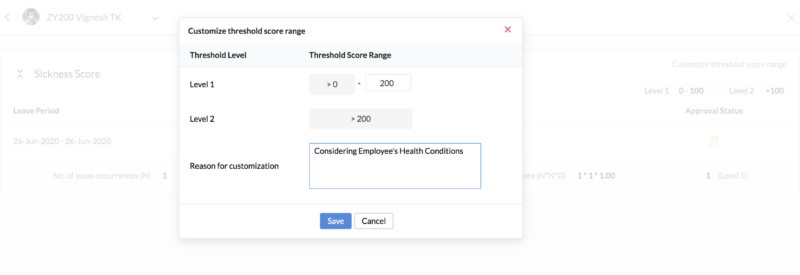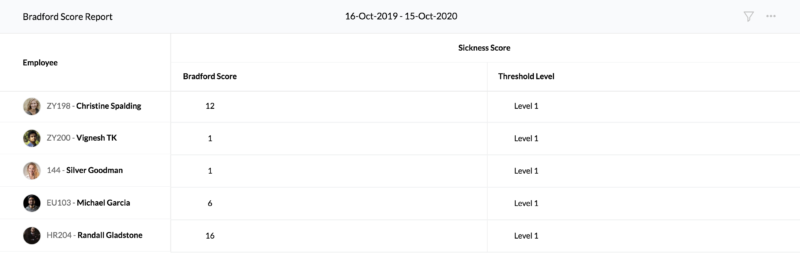Using the Bradford Score to reduce unplanned absences
- Last Updated : August 23, 2023
- 4.0K Views
- 5 Min Read

Frequent and unplanned absenteeism can hinder the success of your business. It leads to significant productivity loss and increases the workload of those employees who are present. Projects can also get delayed because of frequent unplanned absences. Having a well-designed system in place to assess the impact of employee absenteeism on your organization will allow you to take necessary precautions before problems arise. The Bradford Score is a formula that gives you clear visibility into the effect of employee absenteeism. In this article, we break down the basics of the Bradford score and how it can be applied in Zoho People, our HR software:
What is the Bradford Score?
The Bradford Score is widely used by many HR departments to measure the impact of employee absenteeism by calculating the “absence score” of each employee. It suggests that frequent unplanned absences cause more problems than long, well-planned absences. A higher Bradford Score means that employee absences are happening more often, and they aren’t planned in advance. This leads to less success for the business. A lower Bradford Score means employee days off are well-planned, and they have less impact on your organization’s overall operations.
Why use the Bradford Score?
When their peers take unexpected days off, it increases the work responsibilities of employees who are present at work. If this pattern is allowed to continue, they will experience burnout, and their overall productivity and engagement will drop. The quality of work they do will also dip drastically. This will leave your employees feeling unhappy, and it can even create a toxic work environment in your organization. If that wasn’t bad enough, unplanned absences can delay your organization’s overall work progress, which affects customer service. As you can see, a cascading effect forms and starts knocking down the essential pillars of your organization’s success.
Calculating the Bradford Score of each employee can give you an exact picture of how their days off are affecting your business. If the scores are low, that’s a good sign that absences aren’t damaging your business. If the scores are high, this is an indication that appropriate measures should be taken to reduce unscheduled absences.
How to calculate the Bradford Score?
The formula for calculating the Bradford Score is pretty straightforward. You’ll need data for the total occurrences of time off and total number of missed working days for each employee. In Zoho People, we use the term “Leave occurrences” to refer to the number of times your employees took days off. For instance, some of them may take two or three days at once. This counts as one occurrence.
Bradford Score: Leave occurrences * Leave occurrences * Missed working days
Consider two employees, Employee A and Employee B. Employee A has applied for 6 days of leave 6 times. Employee B has applied for the same 6 days of leave 3 times.
Bradford score of Employee A: 6*6*6 = 216
Bradford Score of Employee B: 3*3*6 = 54
Here, Employee A and Employee B have taken an equal number of holidays. However, the Bradford score of Employee A is higher than Employee B. Employee B has planned their leaves well in advance and their leaves are less disruptive—unlike Employee A, who has taken short, frequent, and unplanned leaves.
The Bradford Score in Zoho People
Recently in Zoho People, we have introduced the Bradford Score feature under our Leave Management System to help our customers reduce the negative effect of unplanned absences. Calculating the Bradford Score of every employee manually can be time-consuming. With the Bradford Score feature in Zoho People, the complete score calculation process for every employee is automated. Here’s how the Bradford Score works in Zoho People:
Adding score types
In Zoho People, you choose the leave type you wish to have a score for. Here, you can give the score a particular name and add leave types applicable to that score. For example, if the score type is sick leave, you can add paid sick leave and unpaid sick leave under it.

After this, the number of threshold levels should be defined and the range of each threshold level should be configured. For example, consider that you select three threshold levels. The range of each threshold level can be:
Level 1: 0- 100
Level 2: 100 – 200
Level 3: > 200
You can define a maximum of five threshold levels for each score type in Zoho People. Learn how to add Bradford Score types in Zoho People.
Customizing the threshold score range
Some of your employees may have genuine reasons to frequently take days off, such as having a medical condition. Having the same threshold score range for them may not be fair. To protect their interests, we have an exclusive setting in the Bradford Score feature that allows you to customize the threshold score range for a specific employee.

Once the threshold level is customized, the reason for customization, name of the person who customized it, and the threshold score range before customization will be displayed for reference. Learn how to customize the threshold score range.
Viewing reports
The Bradford Score reports of each employee indicate their Bradford Score and their associated threshold level. Employees can be filtered based on the score type, threshold level, location, unit, designation, and more.

The detailed breakdown of the score can be viewed by selecting the name of the employee. Here you will see a complete list of the leave periods, leave types, number of workdays missed, the reason for each leave, and the status of their leave approval for 12 months, based on the date selected. Below that, you will be able to see the breakdown of the Bradford Score calculation. Learn how to view the Bradford Score Reports.
Merging and splitting the time off instances
Sometimes your employees may take time off on different days, but for the same reason. For instance, consider that one of your employees is injured and takes leave. The same employee might have to take leave on some other day for a follow-up medical appointment. In such cases, you can merge those two situations to one as a Zoho People admin. This will reduce their Bradford Score. You can also split leave occurrences the same way. Learn how to merge and split leave occurrences under Bradford Score.

Adding workflows
Workflows can be created to send email alerts to employees, HR managers, admins, and reporting managers when an employee’s Bradford Score exceeds the limit for a particular leave type, reaches a particular level, changes threshold levels, and more. This will help you monitor the Bradford Score closely and communicate with employees better about their time off.
Wrapping up
The Bradford Score allows you to keep an eye on the impact of unplanned absences on your organization. It’s simple, efficient, and easy to use. However, this should not be the only metric considered when taking stock of an employee’s performance and contribution to the success of the business.
In Zoho People, the Bradford Score feature is designed to help your organization reduce the impact of unplanned absences on your organization. It also allows you to be more fair with the score by providing score threshold customization for each employee. This way, you will be able to balance the workload equally, ensure that no one employee is over-burdened because of their coworkers’ absences, and increase overall employee satisfaction. Learn how to enable the Bradford Score in your Zoho People account.
Please note that Bradford Score feature is available only for Enterprise Customers in Zoho People.
 Tarika
TarikaContent Specialist at Zoho People


